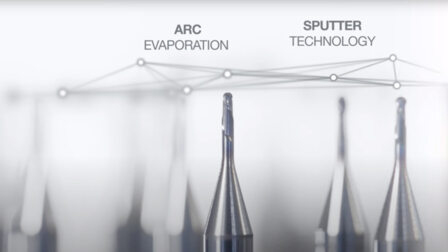
Choose your country / language
Global
Americas
-
 Argentina
Argentina
-
 Brazil
Brazil
-
 Canada
Canada
-
 Mexico
Mexico
-
 USA
USA
Europe
-
 Austria
Austria
-
 Belgium
Belgium
-
 Czech Republic
Czech Republic
-
 Finland
Finland
-
 France
France
-
 Germany
Germany
-
 Hungary
Hungary
-
 Italy
Italy
-
 Luxembourg
Luxembourg
-
 Netherlands
Netherlands
-
 Poland
Poland
-
 Portugal
Portugal
-
 Romania
Romania
-
 Slovakia
Slovakia
-
 Sweden
Sweden
-
 Turkey
Turkey
-
 United Kingdom
United Kingdom
Asia
-
 China
China
-
 India
India
-
 Indonesia
Indonesia
-
 Japan
Japan
-
 Korea
Korea
-
 Malaysia
Malaysia
-
 Philippines
Philippines
-
 Singapore
Singapore
-
 Vietnam
Vietnam

S3p –Scalable pulsed power plasma - พลาสม่ากำลังสูงแบบปรับได้
The Smooth Revolution - Follow the Flow of Intelligence
Oerlikon Balzers - S3p
S3p เป็นการผสมผสานข้อดีของเทคโนโลยีการระเหยด้วยอาร์คเข้ากับข้อดีของเทคโนโลยีการทำสปัตเตอริ่ง:
- มีการไอออไนเซชั่นในระดับสูง โดยไม่เกิดหยดโลหะเหลว
- ผิวเคลือบมีความเรียบ
- ผิวเคลือบมีความหนาแน่นและความแข็งสูงมาก
- การยึดเกาะดีเยี่ยม
ช่วงการทำงานที่ดีกว่าและสามารถปรับค่าต่างๆ ได้อิสระ เช่น
- ระยะเวลาของพัลส์
- รูปทรงของพัลส์
- ความหนาแน่นของกระแส
เปิดโอกาสสู่การออกแบบการเคลือบผิวในรูปแบบใหม่ๆ ที่ไม่เคยมีมาก่อน S3p ช่วยให้การเคลือบผิวออกแบบเฉพาะที่สามารถตอบโจทย์ความต้องการของงานแต่ละประเภทได้อย่างตรงจุด กลายเป็นความจริงขึ้นมาได้
Arc Evaporation
ในกระบวนการระเหยด้วยอาร์ค กระแสไฟฟ้ากำลังสูงจุดเล็กๆ จะเคลื่อนที่ไปบนพื้นผิวของสารเคลือบเป้าหมาย ทำให้วัสดุหลอมละลายทันที และไอระเหยโลหะจะควบแน่นลงบนพื้นผิวของชิ้นงาน วิธีการนี้เป็นการทำงานที่มีการระเบิดของพื้นผิว จึงมักจะทำให้เกิดหยดโลหะเหลว ซึ่งอาจทำให้ผิวเคลือบไม่เรียบได้ กระบวนการนี้สามารถมีการจ่ายก๊าซที่ไวต่อปฏิกิริยา เพื่อสร้างให้เกิดเป็นสารประกอบได้
ลักษณะเฉพาะของกระบวนการนี้:
- มีการไอออไนเซชั่นในระดับสูง
คุณสมบัติของชั้นเคลือบผิว:
- ความหนาแน่นสูง ความแข็งสูง
- การยึดเกาะดีเยี่ยม
- ผิวเรียบน้อยกว่า อาจมีหยดโลหะเหลว
Sputtering
การทำสปัตเตอริ่งเป็นกระบวนการที่ทำให้อะตอมถูกปล่อยออกมาจากวัสดุของแข็งที่เป็นเป้าหมาย โดยการยิงอนุภาคพลังงานไปยังวัสดุเป้าหมายดังกล่าว ในส่วนของการเคลือบผิวแบบฟิล์มบาง การปล่อยอะตอมจะทำโดยการเร่งความเร็วของไอออนอาร์กอนเข้าหาเป้าหมายที่เป็นของแข็ง โดยไอออนดังกล่าวจะกระแทกกับวัสดุเพื่อคายอะตอมของโลหะออกมา จากนั้น จึงตกเคลือบลงบนชิ้นงาน การสร้างสารประกอบ เช่น โลหะไนไตรด์ สามารถทำได้โดยการจ่ายก๊าซเข้าสู่ห้องสุญญากาศ
ลักษณะเฉพาะของกระบวนการนี้:
- มีการไอออไนเซชั่นในระดับต่ำ
คุณสมบัติของชั้นเคลือบผิว:
- ความหนาแน่นต่ำ ความแข็งต่ำ
- การยึดเกาะปานกลาง
- ผิวเรียบ
Coatings that write history
A technological milestone has been achieved: BALIQ™ - the new coating generation by Oerlikon Balzers. It is based on our S3p technology (Scalable Pulsed Power Plasma) that intelligently combines the advantages of arc evaporation and sputtering.
The result is BALIQTM, a new family of wear-resistant coatings with revolutionary properties for a unique spectrum of applications. You benefit from new possibilities that transcend anything seen before – with coatings tailored precisely to your needs.
© Copyright 2025 OC Oerlikon Management AG
กลับไปที่ด้านบน keyboard_arrow_up






